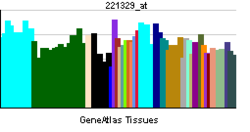- OR52A1
-
Olfactory receptor, family 52, subfamily A, member 1 Identifiers Symbols OR52A1; HPFH1OR External IDs HomoloGene: 114685 GeneCards: OR52A1 Gene Gene Ontology Molecular function • transmembrane receptor activity
• olfactory receptor activityCellular component • plasma membrane
• integral to plasma membraneBiological process • signal transduction
• sensory perception of smell
• response to stimulusSources: Amigo / QuickGO RNA expression pattern 
More reference expression data Orthologs Species Human Mouse Entrez 23538 18369 Ensembl ENSG00000182070 ENSMUSG00000061626 UniProt Q9UKL2 n/a RefSeq (mRNA) NM_012375 NM_013620.2 RefSeq (protein) NP_036507 NP_038648.2 Location (UCSC) Chr 11:
5.17 – 5.21 MbChr 7:
110.93 – 110.93 MbPubMed search [1] [2] Olfactory receptor 52A1 is a protein that in humans is encoded by the OR52A1 gene.[1][2]
Olfactory receptors interact with odorant molecules in the nose, to initiate a neuronal response that triggers the perception of a smell. The olfactory receptor proteins are members of a large family of G-protein-coupled receptors (GPCR) arising from single coding-exon genes. Olfactory receptors share a 7-transmembrane domain structure with many neurotransmitter and hormone receptors and are responsible for the recognition and G protein-mediated transduction of odorant signals. The olfactory receptor gene family is the largest in the genome. The nomenclature assigned to the olfactory receptor genes and proteins for this organism is independent of other organisms.[2]
Contents
See also
References
- ^ Feingold EA, Penny LA, Nienhuis AW, Forget BG (Nov 1999). "An olfactory receptor gene is located in the extended human beta-globin gene cluster and is expressed in erythroid cells". Genomics 61 (1): 15–23. doi:10.1006/geno.1999.5935. PMID 10512676.
- ^ a b "Entrez Gene: OR52A1 olfactory receptor, family 52, subfamily A, member 1". http://www.ncbi.nlm.nih.gov/sites/entrez?Db=gene&Cmd=ShowDetailView&TermToSearch=23538.
Further reading
- Bulger M, Bender MA, van Doorninck JH, et al. (2001). "Comparative structural and functional analysis of the olfactory receptor genes flanking the human and mouse beta-globin gene clusters.". Proc. Natl. Acad. Sci. U.S.A. 97 (26): 14560–5. doi:10.1073/pnas.97.26.14560. PMC 18958. PMID 11121057. http://www.pubmedcentral.nih.gov/articlerender.fcgi?tool=pmcentrez&artid=18958.
- Strausberg RL, Feingold EA, Grouse LH, et al. (2003). "Generation and initial analysis of more than 15,000 full-length human and mouse cDNA sequences.". Proc. Natl. Acad. Sci. U.S.A. 99 (26): 16899–903. doi:10.1073/pnas.242603899. PMC 139241. PMID 12477932. http://www.pubmedcentral.nih.gov/articlerender.fcgi?tool=pmcentrez&artid=139241.
- Malnic B, Godfrey PA, Buck LB (2004). "The human olfactory receptor gene family.". Proc. Natl. Acad. Sci. U.S.A. 101 (8): 2584–9. doi:10.1073/pnas.0307882100. PMC 356993. PMID 14983052. http://www.pubmedcentral.nih.gov/articlerender.fcgi?tool=pmcentrez&artid=356993.
- Gerhard DS, Wagner L, Feingold EA, et al. (2004). "The status, quality, and expansion of the NIH full-length cDNA project: the Mammalian Gene Collection (MGC).". Genome Res. 14 (10B): 2121–7. doi:10.1101/gr.2596504. PMC 528928. PMID 15489334. http://www.pubmedcentral.nih.gov/articlerender.fcgi?tool=pmcentrez&artid=528928.
External links
This article incorporates text from the United States National Library of Medicine, which is in the public domain.
Class II
(tetrapod specific receptors)Family 1Family 2A1 · A2 · A4 · A5 · A7 · A12 · A14 · A25 · A42 · AE1 · AG1 · AG2 · AJ1 · AK2 · AP1 · AT4 · B2 · B3 · B6 · B8 · B11 · C1 · C3 · D2 · D3 · F1 · F2 · G2 · G3 · G6 · H1 · H2 · J1 · J2 · J3 · K2 · L2 · L3 · L5 · L8 · L13 · M2 · M3 · M4 · M5 · M7 · S2 · T1 · T2 · T3 · T4 · T5 · T6 · T8 · T10 · T11 · T12 · T27 · T29 · T33 · T34 · T35 · V1 · V2 · W1 · W3 · W5 · Y1 · Z1
Family 3Family 4Family 5Family 6Family 7Family 8Family 9Family 10Family 11Family 12Family 13Categories:- Human proteins
- Transmembrane receptor stubs
- G protein coupled receptors
Wikimedia Foundation. 2010.
